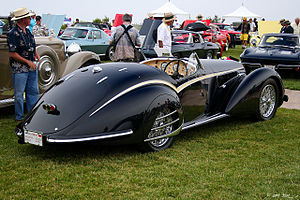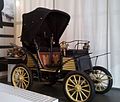The Cars PortalA car, or an automobile, is a motor vehicle with wheels. Most definitions of cars state that they run primarily on roads, seat one to eight people, have four wheels, and mainly transport people rather than cargo. There are around one billion cars in use worldwide. The French inventor Nicolas-Joseph Cugnot built the first steam-powered road vehicle in 1769, while the Swiss inventor François Isaac de Rivaz designed and constructed the first internal combustion-powered automobile in 1808. The modern car—a practical, marketable automobile for everyday use—was invented in 1886, when the German inventor Carl Benz patented his Benz Patent-Motorwagen. Commercial cars became widely available during the 20th century. The 1901 Oldsmobile Curved Dash and the 1908 Ford Model T, both American cars, are widely considered the first mass-produced and mass-affordable cars, respectively. Cars were rapidly adopted in the US, where they replaced horse-drawn carriages. In Europe and other parts of the world, demand for automobiles did not increase until after World War II. In the 21st century, car usage is still increasing rapidly, especially in China, India, and other newly industrialised countries. Cars have controls for driving, parking, passenger comfort, and a variety of lamps. Over the decades, additional features and controls have been added to vehicles, making them progressively more complex. These include rear-reversing cameras, air conditioning, navigation systems, and in-car entertainment. Most cars in use in the early 2020s are propelled by an internal combustion engine, fueled by the combustion of fossil fuels. Electric cars, which were invented early in the history of the car, became commercially available in the 2000s and are predicted to cost less to buy than petrol-driven cars before 2025. The transition from fossil fuel-powered cars to electric cars features prominently in most climate change mitigation scenarios, such as Project Drawdown's 100 actionable solutions for climate change. (Full article...) Entries here consist of Good and Featured articles, which meet a core set of high editorial standards.
The Simca Vedette is an executive car, manufactured from 1954 to 1961 by French automaker Simca, at their factory in Poissy, France. The Vedette competed in France's large car market at a time when the economy was finally returning to growth and enjoyed moderate success with its American style finished off by the Italian designer Rapi. It was marketed with different model names according to trim and equipment levels. The Vedette was Simca's largest model at that time, and it went on to spawn a more economical version, the Simca Ariane. Simca acquired the Poissy factory from Ford France (Ford Société Anonyme Française, the French subsidiary of the Ford Motor Company), along with the model line, in 1954. The Vedette was therefore initially still marketed as the Ford Vedette. The Vedette was manufactured in Poissy until 1961 and the Ariane until 1963. After that, production continued in Brazil until 1966, when the Vedette finally evolved into the Simca Esplanada following Simca's takeover by Chrysler. (Full article...) Selected article - A pickup truck or pickup is a light or medium duty truck that has an enclosed cabin, and a back end made up of a cargo bed that is enclosed by three low walls with no roof (this cargo bed back end sometimes consists of a tailgate and removable covering). In Australia and New Zealand, both pickups and coupé utilities are called utes, short for utility vehicle. In South Africa, people of all language groups use the term bakkie; a diminutive of Afrikaans: bak, meaning bowl or container. Once a work or farming tool with few creature comforts, in the 1950s, US consumers began purchasing pickups for lifestyle reasons, and by the 1990s, less than 15 percent of owners reported use in work as the pickup truck's primary purpose. In North America, the pickup is mostly used as a passenger car and accounts for about 18% of total vehicles sold in the United States. Full-sized pickups and SUVs are an important source of revenue for major car manufacturers such as Ford, General Motors, and Stellantis, accounting for more than two-thirds of their global pre-tax earnings, though they make up just 16% of North American vehicle production. These vehicles have a high profit margin and a high price tag; in 2018, Kelley Blue Book cited an average cost (including optional features) of US$47,174 for a new Ford F-150. (Full article...) Selected picture of the day
Selected biography -Thomas Howard White (April 26, 1836 – June 22, 1914) was an American industrialist and philanthropist. In 1876 he founded the White Sewing Machine Company in Cleveland, Ohio, predecessor of White Consolidated Industries. He was also an automotive pioneer through the White Motor Company, which went on to produce cars, trucks, buses and tractors. In 1913 he established the Thomas H. White Charitable Trust, which is still active as the Thomas H. White Foundation. (Full article...) On this day February 8
Did you know...
Selected quote of the dayTopicsGeneral imagesThe following are images from various car-related articles on Wikipedia.
CategoriesThings you can do to help If you wish to help, you can:
Associated WikimediaThe following Wikimedia Foundation sister projects provide more on this subject:
Discover Wikipedia using portals
|
Aja viide. Aja lugu.
Ilm, huumor ja uudiseid
Värsked postitused
- Eesti epeenaised avaringis ei vääratanud
- Kanadalanna näitas sisetingimustes viimase tosina aasta pikimat kuulikaart
- Vana-Kalamaja tänava arhitekt: Tallinn on kergliikleja jaoks igavene hädaorg
- Balti elektrisüsteem on Venemaa omast lahti ühendatud, töötab tõrgeteta
- Eesti digitaalse meelelahutuse tõus ja mõju




















































































You must be logged in to post a comment.